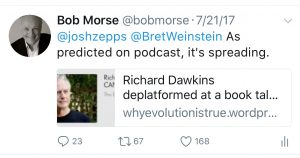by Bob | Aug 12, 2017 | Life notes, Social Media
 I’m an early adopter of Twitter and I really liked it when I started. Then I sort of just forgot about it for a couple years. I can’t really explain my neglect. I think I just got distracted by exploring all the other tools that developed, including, the Facebook monster.
I’m an early adopter of Twitter and I really liked it when I started. Then I sort of just forgot about it for a couple years. I can’t really explain my neglect. I think I just got distracted by exploring all the other tools that developed, including, the Facebook monster.
Recently I have gone back to Twitter, started to get involved again, and am remembering why I was originally drawn to this particular social media platform. From the beginning, Twitter’s structure has made it challenging to understand for the casual user. The open API adds another level of complexity with lots of third party apps building on top of Twitter adding functionality.
Th ability to direct Tweets at other users by including their handles, the hashtag (#) system allowing for Tweets to be discovered by others and categorizing content creates the possibility for a great amount of interaction between people of all types, not just your “friends” on Facebook.
The same features that can make Twitter feel like a worldwide open discussion also allow for trolls a bots to shadow that world. These things can make Twitter seem like a mean and frightening place. Many well-intentioned people have been driven off Twitter by its dark side. So, if you decide to play in that schoolyard you may need to arm your heart agains the bullies.
The complexity, the seeming chaos, the potiential threats, virtual and real life that can emerge, are all reasons that are probably why Twitter’s user numbers continue to struggle compared the anodyne but seemingly magnetic Facebook. But if you can wrap your arms and mind around all that, it can be a fascinating, exciting and fun place. This time around, I can’t seem to stay away for long. A day off Twitter and I fall victim to FOMO (Fear of Missing Out). My fingers begin to twitch.
Still, I think of myself as a novice. Features have been added since I first started years ago. The third-party tools have changed. New strategies and techniques that I had never heard of have evolved. I barely have enough time to stumble around in the platform, let alone make a concerted effort to study the techniques for effect particiapation.
One of my stumbles forward was when I made the following post after listening to a podcast about free speech. Shortly after finishing the episode I saw a related news story and tweeted the participants in the podcast about that story.

This post caught the eye of many people. It was retweeted many times, “liked” (thes heart icon) by hundreds and a conversation with many, many people (the cartoon talk bubble icon) involved for about two weeks. Given the average life span on a Twitter news feed is about 20 minutes, this was astounding, at least for me.
It’s difficult to say what triggered this reaction. Probably, it was a perfect combination of the topic (free speech is a hot topic on Twitter), including the two Twitter handles of the people involved in the podcast and the news item about Richard Dawkins having his talk at U.C. Berkeley cancelled.
I’ve yet to recreate the success of this Tweet. I don’t consciously set out to do so. But it is in the back of my mind as I fumble my way. Since I do use the platform to also talk about my business, perhaps it’s time to learn, to make an effort to be more systematic, strategic and effective. If you’re on Twitter (and I encourage you to be), please follow me and see how I do. I will follow you back. Promise!

by Bob | Apr 27, 2014 | Life notes, Social Media
We Are All Data
Already we feel compelled to post so much of what we do on Facebook in order to validate our activities or to prove how active we are or what scrumptious meals we make. We share our photos, our thoughts, our blog posts. We all (well not all are on Facebook [yet] and Facebook users are not equally compulsive [yet], I realize I am using hyperbole, but it’s getting harder to avoid, is it not?), OK, I do this.
And it’s not just what you normally think of as Facebook. The corporation is sucking in other tools that can be used to share your life data. I’m looking at you Instagram. Now comes news that FB has purchased the activity tracker Moves.
UPDATE: Moves just published its new Privacy Policy. As expected, here’s the relevant piece:
- We may share information, including personally identifying information, with our Affiliates (companies that are part of our corporate groups of companies, including but not limited to Facebook) to help provide, understand, and improve our Services.
“…improve our Services…” can be very broadly interpreted.
We Are All Product
Moves tracks where you go, how fast you go and how long it took you to go there. To the right is an example of my activity for Saturday, April 26, 2014. It graphs that activity to mapping software as well. So, now Facebook knows that much more about me going back to June of last year since the app is in my phone and my phone is with me almost all the time.
While Facebook says it will not integrate Moves, Instagram, WhatsApp and other recently acquire tools into its social graph directly, this doesn’t preclude it from sucking the accumulated data into its vast maw and getting it to line up with all the other stuff I have voluntarily shared. And they can use that data in all sorts of ways to make money. I am the product. We are all the product.
Rage Against the Machine?
I’m really not sure how to think about this. I like Facebook. I love Moves. And this is only the tip of the iceberg of knowledge that Facebook gathers about me. Every time I login somewhere else using Facebook or even just browse the web Facebook is tracking.
And it’s not just Facebook, though it’s arguably the most successful behemoth. The Internet is awash with applications and companies gathering and sharing my data. It’s huge business.
I could unplug. But since I make my living on the Internet, that’s not very practical. I could use counter measures and tools to protect my privacy, but that in itself could be at least a part-time job. Maybe I worry to much. Maybe, instead, I should relax as we will soon have reached that new Eden that Richard Brautigan wrote about in 1967:
“I like to think
(it has to be!)
of a cybernetic ecology
where we are free of our labors
and joined back to nature,
returned to our mammal
brothers and sisters,
and all watched over
by machines of loving grace.“
======
How are you handling your data/privacy in this brave new world? Comment! Please…
by Bob | Feb 27, 2013 | Local Tech Notes, SEO, Social Media
On February 26 I gave a brief presentation co-sponsored by North Coast Small Business Development Center and the Redwood Technology Consortium’s Internet Marketing Group. As the title suggests it was a high level overview of the current state of social media marketing and my opinions on what works and what doesn’t. The slideshow isn’t that informative, but here it is in any case. Links to resources mentioned are below.
Resources Mentioned
I think the core of my talk is the section on Content Marketing. That’s the new buzzword but for years the mantra has been Content is King and it’s essentially the same concept: Create valuable content whether it’s with a blog, newsletter, training videos, white papers, case studies, even testimonials. Embed that stuff in your site (good for SEO) and then post about those things on as many places and platforms as you can. Social Media Marketing should have 2 goals:
- Get people to market for you: If you provide value they will.
- Drive traffic to your site where you can control the experience (capture leads and/or conduct transactions).
I would love to hear your experiences with making social media marketing effective and efficient. And any great tools you discover along the way. Add your comments below! And as always, please share this post on your networks.
by Bob | Nov 14, 2012 | Life notes, Social Media
Interesting. Seems simple enough. I like that. Very quick.

Using it on the iPhone.
by Bob | Jul 31, 2012 | Local Tech Notes, Social Media
Update: the app just received an upgrade with many improvements.
While sitting around waiting for a doctor appt. I decided to try out this WordPress app on my iPad. It’s quite simple to set up and connects with either a WordPress hosted or self-hosted site. this will be great for blogging on the run. Or while watching baseball. The one drawback I see is there is no way to insert an image. The editor has limited but adequate formatting tools and a way to insert a link without having to type link code. It also runs on the iPhone.
If you are a blogger using WordPress and have an iOS device, give it a try. It’s free, after all. What can you lose but a few minutes which, in my case, would have been largely wasted anyway?

OK! So I learned a few things:
- You can insert images by clicking on the Edit button on a saved post and then the image icon that appears at the bottom.
- You can edit pages as well as posts. So you could use the app to update any WP site. Not just a blog site.
- You can manage comments.
- You can get stats if you have the Jetpack plugin (or have you blog hosted at WordPress.com).
So anyway, it’s even better than I thought!
by Bob | Mar 15, 2012 | SEO, Social Media
I post a lot on Facebook and Twitter about social media. But if you’re interested in getting more quality traffic to your site through search engines such as Google and Bing, then working on search engine optimization (SEO) is still very important.
There are basically 2 major categories of SEO: 1) On-site optimization which involves building in keywords, properly structuring content and other factors and 2) Off-site link building. A key component to #2 is optimizing what is called anchor text. That is the text that a person sees as a link pointing to your site. The intricacies of anchor text can be hard to grasp and for me to explain. But this video by Rand Fishkin of Seomoz provides a clear tutorial on what anchor text is, why it’s important and how to go about getting links with properly formed text. Enjoy!
 I’m an early adopter of Twitter and I really liked it when I started. Then I sort of just forgot about it for a couple years. I can’t really explain my neglect. I think I just got distracted by exploring all the other tools that developed, including, the Facebook monster.
I’m an early adopter of Twitter and I really liked it when I started. Then I sort of just forgot about it for a couple years. I can’t really explain my neglect. I think I just got distracted by exploring all the other tools that developed, including, the Facebook monster.




